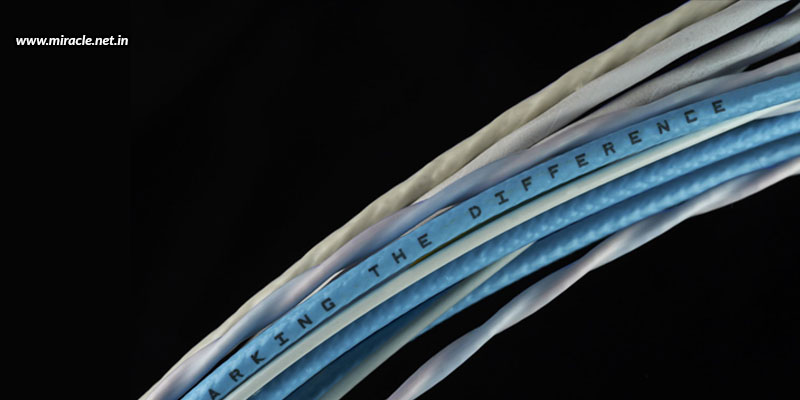“Why should I invest in a laser marking machine, when I can instead buy a less expensive alternative that can serve the same purpose?”

If this is the question that’s in your mind when you’re looking to buy a machine to mark your wires, we’re here to clear your doubts. Once you understand the advantages that laser marking has over other marking methods, you’d say for yourself that it is undoubtedly the best choice for your wires, regardless of your production requirements and the price. UV laser will have you to save money throughout its lifetime, while also proving to be more efficient than any other method.
Laser marking vs. hot stamping
Hot stamping has been a technique used to mark wires since World War II, but today, with the advancements in technologies, it seems to be impractical and dangerous. It is an out-dated method that takes far longer to mark a wire than it would with a UV laser marking machine.
- Hot stamping requires manual changing of characters, while UV laser marking uses a software to control the marking of characters, making the latter faster, requiring less operator time.
- With Teflon wires continuing to grow in popularity, using a hot stamping machine makes trouble marking on these wires. But, with laser markers, Teflon wires can be easy to mark.
- Hot stamping requires a certain width of the wire to be marked, as well as a thick insulation. Laser markers, on the other hand, can safely mark on even thin-insulated and small gauge wires, without any risk to the integrity of the cable.
- Hot stamping always keeps the wire at risk of getting burnt, which means the wire damaged even before being installed into the application. But, with laser marking, there is no such worry, as it simply tans the wire insulation, leaving a permanent mark, and maintaining the integrity of the wire.
Laser marking vs. heat shrinking
Heat shrinking is another popular method used to mark wires, but it is a long and labour-intensive process, which proves to be highly inefficient. It fails to address the needs of businesses looking to expand, as it is low on efficiency and speed, while being high on costs. Laser marking, on the other hand, eliminates the cost of applying more resources over the wire, also reducing the need for post mark treatment. This helps companies focus on cost savings, improved capacities, and long-term growth.
- In the process of heat shrinking, the user is required to manually carry out the entire process – marking the tubing, marking the wire, cutting the tubing and wire with precision, inserting it over the wire, heating both ends of the wire, and finally inserting the wire into the destination. Laser marking, on the other hand, is absolutely easy and automatic. It marks the wire directly, and then cuts it to the required length automatically, with no need for post mark treatment.
- In the case of heat shrinking, dirt or grime can get into the tube and be inserted over the wire, making the wire slippers and difficult to install, thus making it a difficult and time-consuming job, which is responsible for increasing labour hours. But, with laser marking, there is no such process. The wire that goes into the machine comes out itself, with no possibility of dirt and grime getting into the crevasses.
Laser marking vs. ink jet printing
Ink jet printers are very fast and mark at higher speeds than laser markers. However, they also pose multiple disadvantages to the wires.
- The markings made by ink jet printers are not permanent. Any liquids that touch the markings, such as gasoline or jet fuel, can remove or smear the mark on the wire. Laser markers, on the contrary, tan the wire insulation, creating a permanent mark that cannot fade or smear.
- Ink jet printers are high on maintenance. They require cleaning the ink applicator, checking for fading ink, and changing the cartridge. This not only results in high maintenance costs, but also increased down time and daily consumables, which add to the mounting operating costs. Laser markers, in opposition, require no ink, and have no daily consumables and maintenance.
After looking at all the above factors, it becomes clear that laser marking is the most efficient process that brings permanent results. It is a fast, safe, efficient, permanent, long-term solution, increasing marking capacity and reducing operator costs. Laser marking can thus save the business money in terms of time, cost, and maintenance. You can approach Miracle Electronics for laser marking for aircraft cables, no matter what your wire material, gauge size, character requirements, and spacing constraints.
Miracle Also , do subcontracting for Laser Marking on Cables with it’s spare capacity , You may send your requirements to us on sales@miracle.net.in